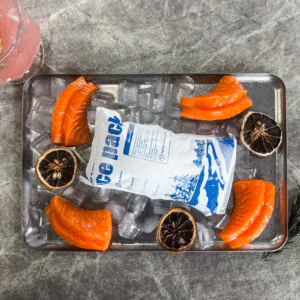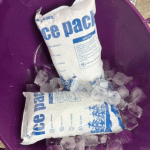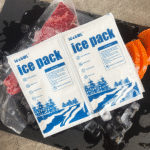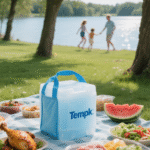Comment utiliser de la glace carbonique dans une glacière: Un guide complet pour 2025
La glace carbonique est la solution ultime pour conserver les articles congelés pendant de longues périodes. Idéal pour les longs voyages, pannes de courant, ou l'expédition d'articles périssables, il est essentiel de comprendre son utilisation sûre et sa manipulation appropriée. Dans ce guide, nous explorerons tout ce que vous devez savoir sur l'utilisation de la glace carbonique dans les glacières, y compris les meilleures pratiques, consignes de sécurité, et les dernières tendances en 2025.

Qu'est-ce que la glace carbonique et comment ça marche?
La glace sèche est la forme solide de dioxyde de carbone (Co₂), connue pour sa température exceptionnellement froide de -78,5°C (-109.3°F). Contrairement à la glace ordinaire, qui fond dans l'eau, la neige carbonique se sublime directement d'un solide à un gaz, ne laissant aucun résidu. Cette propriété unique le rend idéal pour maintenir des températures froides pendant le transport ou le stockage, surtout quand l'eau provenant de la glace ordinaire pourrait être nocive.
Pourquoi choisir la glace carbonique plutôt que la glace ordinaire?
La glace carbonique offre de nombreux avantages par rapport à la glace traditionnelle:
-
Température inférieure: La glace carbonique maintient les articles congelés bien en dessous du point de congélation de l'eau., ce qui est essentiel pour conserver des aliments comme la viande, vaccins, et les produits biotechnologiques.
-
Pas d'eau de fusion: Depuis la glace sèche sublime dans le gaz co₂, il n'y a pas de gâchis à nettoyer, ce qui le rend idéal pour le transport à sec.
-
Durée de refroidissement plus longue: La glace sèche dure beaucoup plus longtemps que la glace ordinaire, réduisant le besoin de réapprovisionnements fréquents lors de longues expéditions ou d'un stockage prolongé.
Cependant, la neige carbonique a ses limites. Il nécessite une manipulation soigneuse pour assurer une bonne ventilation grâce au gaz CO₂, et sa durée de refroidissement est plus courte que la glace ordinaire dans certaines conditions..
Comment utiliser en toute sécurité Glace carbonique dans une glacière
1. Manipuler avec soin
La glace carbonique est extrêmement froide, et le contact direct avec la peau peut provoquer de graves engelures. Portez toujours des gants isolants lorsque vous manipulez de la neige carbonique, et utilisez des pinces ou une serviette pour le placer dans la glacière.
2. Une bonne ventilation est cruciale
Lorsque vous utilisez de la neige carbonique dans une glacière, assurez-vous que la glacière n’est pas hermétique. Ouvrez le bouchon de vidange ou laissez le couvercle légèrement entrouvert pour permettre au gaz CO₂ de s'échapper.. N'utilisez jamais de glace carbonique dans des récipients scellés sans une ventilation adéquate, car l'accumulation de CO₂ peut entraîner une accumulation dangereuse de pression.
3. Placement correct dans la glacière
Pour un refroidissement optimal, placez de la neige carbonique au fond de la glacière, Alors que l'air froid coule. Évitez de placer de la neige carbonique directement sur les aliments, car cela peut le faire geler et ruiner la texture. Plutôt, utilisez une barrière comme du carton ou des serviettes pour séparer la neige carbonique des denrées périssables.
4. Utiliser l'isolation
Enveloppez la glace carbonique dans du papier journal ou une serviette pour ralentir sa sublimation et protéger le contenu de la glacière du froid extrême.. Cela permet également de minimiser le contact direct avec les aliments.
Meilleures pratiques pour différents scénarios
Pour les longs voyages en voiture
-
Pré-refroidir le refroidisseur: Réduisez la température de la glacière avec de la glace ordinaire avant d'ajouter de la neige carbonique pour un supplément de froid supplémentaire..
-
Utiliser une combinaison: Placez de la glace carbonique au fond et de la glace ordinaire sur le dessus pour un refroidissement optimal.
-
Surveiller les niveaux de CO₂: Assurez-vous que la voiture est bien ventilée pour éviter l'accumulation de CO₂ à l'intérieur du véhicule.
Pour l’expédition d’articles périssables
-
Enveloppez en toute sécurité: Utilisez des emballages isothermes et des matériaux appropriés pour envelopper la neige carbonique.
-
Étiquetez clairement: Marquez le colis avec “Glace sèche” et inclure toutes les instructions de manipulation nécessaires.
-
Vérifier les règlements: Assurez-vous de suivre les réglementations relatives à l’expédition de glace carbonique, y compris les directives de poids et d'emballage.
Pour les situations d'urgence
-
Utiliser avec parcimonie: Appliquez de la glace carbonique uniquement sur les articles qui doivent être congelés.
-
Surveiller l'utilisation: Vérifiez régulièrement le refroidisseur pour vous assurer qu'il maintient des températures basses..
-
Assurer la ventilation: Gardez la glacière dans un endroit bien ventilé pour permettre au gaz CO₂ de se dissiper.
Précautions de sécurité
1. Évitez le contact direct avec la glace sèche
Ne touchez jamais la glace carbonique avec la peau nue. Portez toujours des gants de protection et utilisez des pinces ou d'autres outils pour le manipuler..
2. Assurer une bonne ventilation
Lorsque vous utilisez de la glace sèche, assurez-vous toujours qu’il se trouve dans un endroit bien ventilé. Le gaz qu'il émet peut déplacer l'oxygène et provoquer une suffocation dans des espaces confinés.
3. Transportez la glace carbonique en toute sécurité
Lors du transport de neige carbonique dans une voiture ou tout autre véhicule, assurez-vous que la glacière se trouve dans un espace bien ventilé. Ne laissez jamais de glace carbonique dans un coffre fermé ou dans un espace hermétique., car cela pourrait provoquer une accumulation de pression.
4. Élimination appropriée des restes de glace carbonique
Une fois que vous avez fini d’utiliser de la neige carbonique, laissez-le se sublimer dans un endroit bien aéré. Ne jetez jamais de glace carbonique dans l’évier et ne la placez jamais dans une poubelle scellée., car cela pourrait causer des dommages.
Alternatives à la glace sèche
Bien que la glace carbonique soit très efficace, il existe des alternatives selon la situation:
-
Packs de gel: Réutilisable et maintient des températures froides pendant de longues périodes.
-
Matériaux à changement de phase (PCMS): Ces matériaux sont conçus pour maintenir des températures spécifiques, idéal pour les objets sensibles.
-
Glace ordinaire: Facilement disponible et efficace pour les besoins de refroidissement à court terme.
Conclusion
La glace carbonique reste l'une des meilleures solutions pour maintenir des températures basses pendant le stockage ou le transport.. En suivant les consignes de sécurité, meilleures pratiques, et l'utiliser efficacement, vous pouvez garantir la performance optimale de vos besoins de refroidissement. Donnez toujours la priorité à la ventilation et manipulez la neige carbonique avec précaution pour éviter les accidents..
FAQ
Q1: Quelle quantité de neige carbonique dois-je utiliser dans une glacière?
Une ligne directrice générale consiste à utiliser 5 à 10 livres de glace carbonique par jour pour une glacière de 25 litres. Ajustez en fonction de la taille de la glacière et de la durée de votre voyage.
Q2: Puis-je utiliser de la neige carbonique dans une glacière douce?
Ce n'est pas recommandé. La glace carbonique peut endommager le matériau des glacières souples et nécessite une ventilation adéquate, quels refroidisseurs souples peuvent ne pas fournir.
Q3: Comment conserver la glace carbonique?
Conservez la glace carbonique dans un endroit bien ventilé. Ne le stockez pas dans un récipient scellé, car l'accumulation de gaz CO₂ peut entraîner une augmentation de la pression et potentiellement une rupture du conteneur.
Q4: Puis-je utiliser de la neige carbonique avec de la glace ordinaire?
Oui, la combinaison de glace carbonique avec de la glace ordinaire peut fournir à la fois des capacités de congélation et de refroidissement. Placez de la glace carbonique au fond et de la glace ordinaire sur le dessus pour des performances optimales.
Q5: La glace sèche est-elle sûre pour la nourriture?
Oui, la glace carbonique est sans danger pour les aliments lorsqu'elle est utilisée correctement. Assurer une bonne ventilation et éviter tout contact direct avec les aliments pour éviter de les geler.
À propos du tempk
Tempk est spécialisé dans la fourniture de solutions de refroidissement de haute qualité, y compris les blocs de glace carbonique et les glacières. Nos produits sont conçus pour répondre aux besoins de diverses applications, de l'expédition d'articles périssables aux aventures en plein air. Nous accordons la priorité à la sécurité et à la performance dans toutes nos offres.
Pour plus d'informations ou pour acheter nos produits, visitez notre site Web.






















